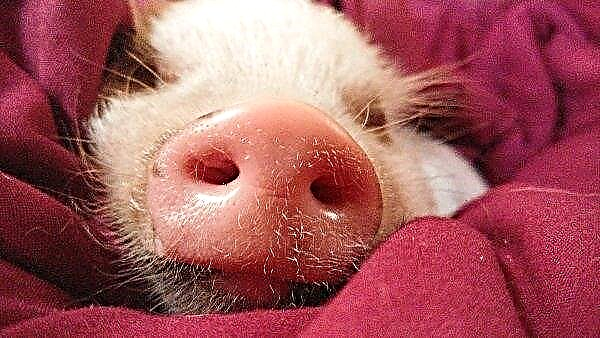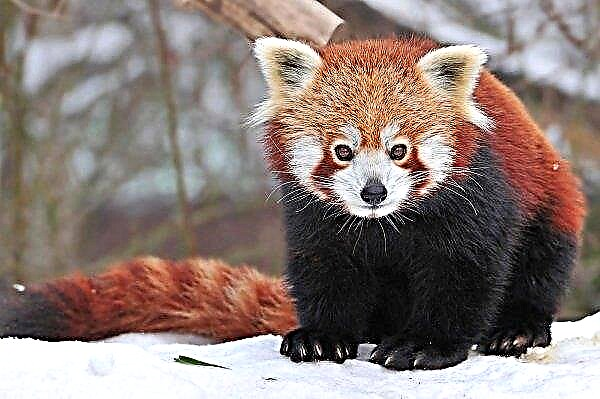The eye is an organ that reflects the state of the whole organism in both humans and animals. Clean, shiny, moving eyes in rabbits indicate that their body is healthy and does not need anything. What to do if purulent discharge appears in front of your eared pets, what eye diseases rabbits suffer from and how to treat them, let's take a closer look.
Why do rabbits have festering eyes?
Suppuration in front of the eyes is a common situation that almost everyone who is involved in breeding rabbits has encountered. Such an ailment can affect an absolutely healthy, at first glance, animal and usually is only a harbinger of an impending disease.
Did you know? The mechanism of the visual system of rabbits is designed in such a way that allows you to get an overview of almost 360° - This ability is due to the natural need for rabbits to escape from predators for survival.
In such a situation, the main task of the breeder is to understand the root causes of the appearance of such a condition and, to understand how and how to treat, correctly diagnose.
Infectious diseases
There are many reasons why rabbits may have suppuration of the eyes, but the main and most common cause is infectious diseases.
Coccidiosis
First of all, coccidia affects the liver (hepatic form of coccidiosis) or the intestinal mucosa (intestinal form of the disease), which leads to the inability of the body to completely digest and absorb food.
As a result of this ailment, exhaustion of the whole organism sets in, rabbits lose weight dramatically - all this without the necessary treatment can lead to the death of the animal.
Important! Unfortunately, even rabbits recovered from coccidiosis should be sent for slaughter, since such an animal is no longer suitable for reproducing offspring.
Symptoms
- acute diarrhea is replaced by constipation, blood and mucous streaks are visible in the litter;
- slow development and growth of rabbits, lack of appetite;
- fever;
- suppuration in the eyes;
- general painful appearance: dull, tousled hair, saggy, swollen belly.
 The hepatic and intestinal forms of coccidiosis have similar symptoms, however, the hepatic type is not so acute and yellowness is added to the general symptoms.
The hepatic and intestinal forms of coccidiosis have similar symptoms, however, the hepatic type is not so acute and yellowness is added to the general symptoms.There are many drugs that can counteract coccidiosis (such as, for example, Baykoks, Phtalazole, Solikoks, Sulfapiridazin), and if you apply them immediately after the onset of the first symptoms, the percentage of surviving rabbits is up to 80%.
Conjunctivitis
A common disease among rabbits is inflammation of the thin tissue that covers the surface of the eye (conjunctiva).
There are many reasons for the appearance of conjunctivitis - it can be mechanical or chemical damage (trauma or clogging, irritation from disinfectants or drugs used in cosmetic procedures), viral infections, vitamin deficiency (due to improper feeding) or a secondary inflammatory process (i.e., the consequence of which any neglected disease).
The acute form of conjunctivitis is most often observed in young rabbits; it is especially dangerous during development in rabbits.
This disease has the following symptoms:
- depressed state, decreased or complete loss of appetite, desire to be in a dark, quiet room;
- constant desire to scratch your eyes;
- high lacrimation, eyelids swollen and red, cilia glued.
 In the future, if proper treatment has not been carried out, the disease takes one of several possible forms, depending on this, the symptoms may vary:
In the future, if proper treatment has not been carried out, the disease takes one of several possible forms, depending on this, the symptoms may vary:- catarrhal form (acute) - swelling of the eyelids and skin around occurs, lacrimation intensifies, discharge from the eyes appears;
- purulent form - an unpleasant smell appears, pus accumulates in the eyes;
- phlegmonous stage - it is considered one of the most acute forms according to the degree of the course of the disease, severe edema appears, the conjunctiva swells and protrudes;
- keratoconjunctivitis form - the appearance of small ulcers and clouding of superficial tissues on the cornea are added to the general symptoms.
If symptoms of conjunctivitis appear, wash the sore eye with any antibacterial solution - a solution of potassium permanganate of a weak concentration or a 2% solution of boric acid is well suited.
Antibiotics can help relieve inflammation, for example, a tetracycline ointment, which is laid behind the eyelid and spreads throughout the eye with massaging movements, or gentamicin drops.
When using them, the eyes of the rabbit are pre-washed with furatsilinovym solution (1 tablet dissolved in 100 ml of hot boiled water and cool).
After the first treatment, the animal in any case should be shown to the veterinarian.
Keratitis
A disease that causes inflammation of the cornea in rabbits. It often proceeds in parallel with conjunctivitis, especially if the cause of this was mechanical damage. In general, such a disease has a number of reasons that can be divided into:
In general, such a disease has a number of reasons that can be divided into:
- mechanical (i.e. there are injuries);
- physical (for example, thermal burns from the sun);
- chemical (exposure to acids, disinfectants, etc.);
- infectious (the disease acts as a consequence of any infectious disease);
- invasive (the disease develops as a result of the presence of parasites in the body).
The main symptoms of keratitis are a change in the color of the cornea to red, an increase in sensitivity to light, a high degree of lacrimation, purulent discharge appears.
This disease is characterized by a rapid course, which leads to ulcers on the cornea.
If such symptoms are found, it is necessary to immediately remove the inflammation with antibacterial drops or ointments, and also use drugs with antibiotics. To maintain eye health, medications that improve corneal regeneration are recommended.
HBVC and myxomatosis
Myxomatosis is a viral infectious disease that is characterized by acute course in the form of purulent conjunctivitis, swelling and tissue accumulation on the head and external genital organs, as well as the formation of small nodular tumors on the skin.
This virus is distinguished by its resistance - all rabbits that managed to get sick with myxomatosis and survive are carriers of this disease for a long time.
The first symptoms of the disease manifest as red spots on the skin, as well as nodules throughout the body. With the further development of the disease, purulent conjunctivitis occurs, edema and formations in the form of nodules appear, breathing becomes difficult, pneumonia quickly develops.
With the further development of the disease, purulent conjunctivitis occurs, edema and formations in the form of nodules appear, breathing becomes difficult, pneumonia quickly develops.
HBVC (rabbit viral hemorrhagic disease) is also a viral disease, most dangerous for rabbits over 1.5 months of age.
With a transient course of the disease (period of 2-3 days), no symptoms can be detected - at some point in the rabbits, convulsive movements of the paws begin and they die. In other cases, the symptoms are manifested in the form of loss of appetite, nervous excitement and irritability, seizures.
Since both HBV and myxomatosis are viral diseases, the infection occurs by airborne droplets. In case of outbreaks of the epidemic of these diseases in the territory where the cells are located, quarantine is introduced, and all rabbits are sent for slaughter.
Today, the only way to avoid an epidemic is the universal vaccination of rabbits that have reached the age of 1.5 months.
Uveitis and dacryocystitis
Uveitis is a disease that causes inflammation of the choroid in rabbits. The causes of the disease can be different: the consequences of infectious diseases, infection of the body with parasites or various injuries.
Usually, if the cause of uveitis was mechanical damage, then only one injured eye is involved in the inflammation process. In other cases, the disease manifests itself in both eyes. The first symptoms may include: high lacrimation, narrowed pupil, swelling and redness. If the disease is diagnosed by a veterinarian, then a decrease in intraocular pressure, a clouded lens, is noticeable.
If the disease is diagnosed by a veterinarian, then a decrease in intraocular pressure, a clouded lens, is noticeable.
Treatment of uveitis is carried out using antibiotics and drugs that can relieve inflammation. Atropine drops are often used to reduce pain.
Dacryocystitis is a congenital disease that occurs with defective growth of molars, which leads to a change in shape and clogging of the nasolacrimal canal. As a result, lacrimation increases and inflammation of the canal occurs, which leads to secondary infection and the formation of purulent discharge.
This disease can be treated, but only with the help of surgical intervention, so most often the rabbits that are bred for meat and skins are sent for slaughter.
Corneal ulcer
Usually this disease develops due to mechanical damage to the eye, but there are cases when a corneal ulcer is a consequence of glaucoma, obstruction of the nasolacrimal canal, or any chronic infectious disease.
It is easy to recognize this disease with the naked eye, and treatment requires surgical intervention, most often with the removal of the eyeball.
Congenital eye diseases
Along with infectious and viral diseases, there are eye diseases with which rabbits are born.
Cataract
This disease leads to clouding of the lens of the eye and is a disease that cannot be completely cured. Continuous supportive therapies can be carried out - they can help slow down the development of cataracts, which, ultimately, leads to blindness.
The exact causes of congenital cataracts have not yet been fully determined, but there are suggestions that intrauterine injuries can become one of the causes of this defect. You can recognize the disease yourself - a small bright spot appears on the eye (the size of the spot can be different, up to the point that it completely covers the entire pupil).
Phacoemulsification is used to treat cataracts - cataract removal through surgery. Cataracts can also develop in older animals, either due to diabetes or parasites.
Glaucoma
Another more often congenital disease, less often acquired with age, which can lead to loss of vision. You can diagnose glaucoma starting from the third month of life in a rabbit.
Symptoms of the initial stage are considered:
- eye pain;
- protrusion of the eye.
Important! A great tendency to glaucoma was revealed in a decorative white New Zealand rabbit.
Only a veterinarian can diagnose such a disease, and usually the only effective method of treatment is surgery to remove the eyeball.
Corneal occlusion
Such a disease manifests itself in the form of corneal overgrowth with connective tissue and is often found in males who have reached the age of five months.
The exact causes of occlusion have not been established, presumably, the problem arises due to a decrease in the processes of supplying tissues with nerves, which ensure their connection with the nervous system. Treatment is carried out by surgical intervention - in simple cases, removal of overgrown tissues from the cornea of the eye follows, in more complex situations, the entire eye.
After surgery, broad-spectrum antibiotics are prescribed.
Mechanical injuries
In addition to infectious and viral diseases, suppurations are often the result of eye injuries.
The reason for this may be:
- getting injured in fights between animals;
- injury to the eye during feeding (pricking with grass or hay);
- damage to the eye when it hits a corner of the cell or any other object.
With mechanical trauma, the eyes swell, swelling appears, the eyelid can be completely covered. Often, such inflammations do not require additional treatment, but broad-spectrum antibiotics are often used to prevent the development of complications.
Other reasons
There are also a number of additional reasons that can lead to corneal irritation:
- Chemical inflammation - often occurs when sanitary measures are not followed (ammonia vapors caused by the evaporation of a large amount of urine in the cell irritate the lining of the eye).
- Land or lime clogging - in such cases, the eyes are washed with saline until the eyes are completely cleared of debris.
- Allergic reaction - you can instill eyes with anti-allergic drops to relieve edema, but it is necessary to establish an allergen, otherwise treatment will not give a result.
First aid at home
Sometimes, the course and development of the disease will depend on how quickly and efficiently the first aid was provided. What to do if the first symptoms are detected? In this case, each rabbit breeder must have a first-aid kit with the necessary drugs:
In this case, each rabbit breeder must have a first-aid kit with the necessary drugs:
- hydrogen peroxide, potassium permanganate or 2% solution of boric acid - antiseptic agents for washing;
- "Furacilin" - anti-inflammatory agent with which the eyes are washed as a solution;
- Dexafort - anti-allergic agent that allows you to remove edema and inflammation of the eyelids;
- picking herbs of plantain, chamomile or dandelion - such decoctions have an anti-inflammatory effect, relieve spasms;
- "Aspirin" - a means for anesthesia and relieving fever.
After prompt assistance for the correct diagnosis and further treatment, it is necessary to consult a veterinarian.
Preventive measures
In order to avoid and to prevent eye diseases in rabbits, special attention should be paid to systematic preventive work, such as:
- keeping conditions must meet the needs of animals - the absence of drafts in the cage is one of the basic requirements;
- the diet should be complete and balanced, rich in vitamins and minerals (special attention is paid to foods containing vitamin A);
- timely and universal vaccination of rabbits;
- the presence of a first-aid kit for the provision of prompt assistance for injuries or suspicions of other diseases.
 Due to the large number of eye diseases in rabbits, as well as the frequent similarity of symptoms, only a veterinarian is usually able to correctly diagnose and prescribe the optimal treatment.
Due to the large number of eye diseases in rabbits, as well as the frequent similarity of symptoms, only a veterinarian is usually able to correctly diagnose and prescribe the optimal treatment.Did you know? The fat on the surface of rabbit ears contains a substance that in the light is converted to vitamin D. Thus, rabbits, licking their paws after cleaning their ears, get a vitamin supplement.
It is also worth noting that in productive rabbits the treatment of diseases and recovery after them (with the exception of minor mechanical damage or mild conjunctivitis) are often very costly, so these animals are sent for slaughter.












